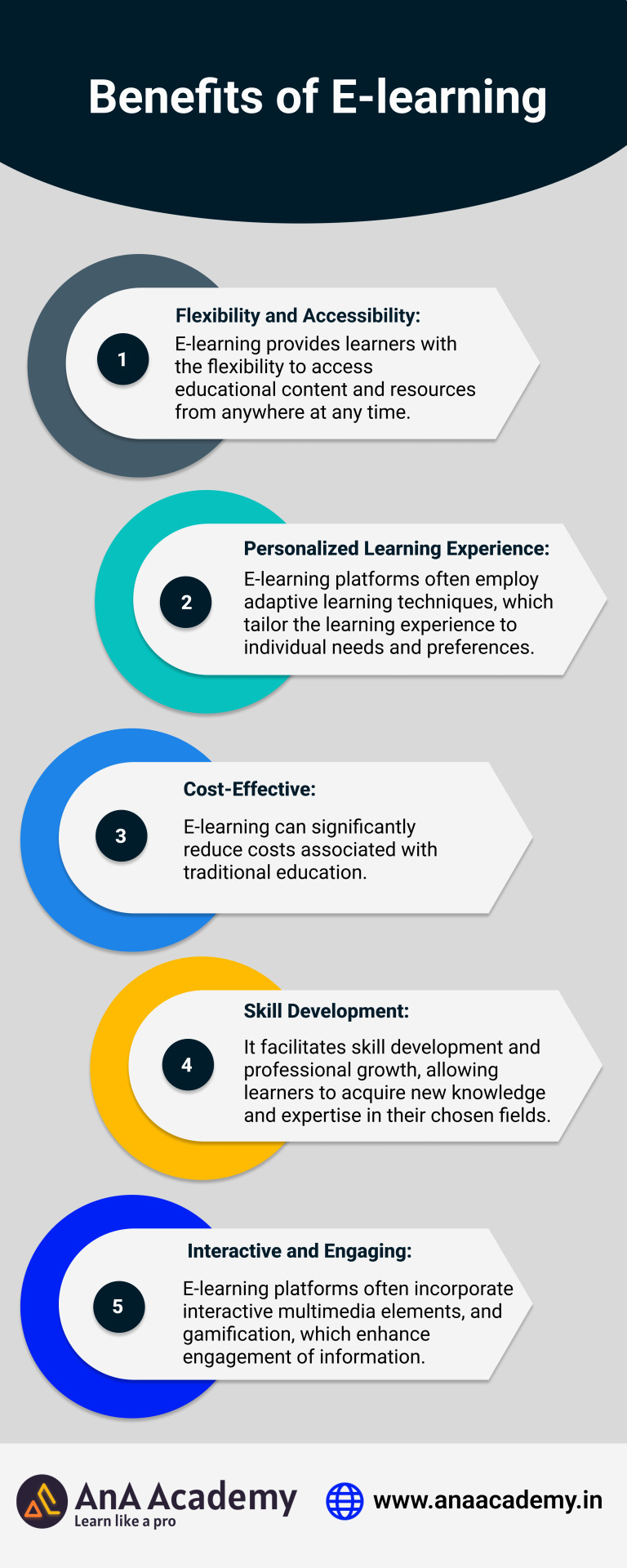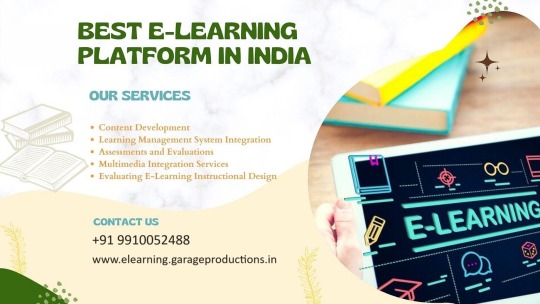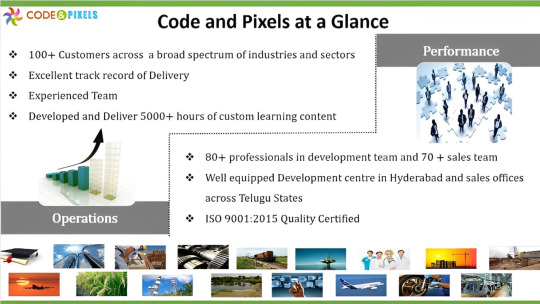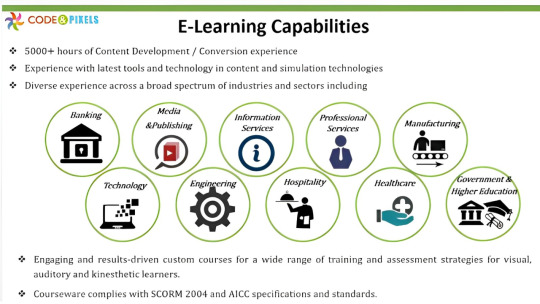#e learning management system
Text

Unlock boundless opportunities for learning with e-learning, where flexibility meets accessibility. Harness the power of personalized education, empowering learners to tailor their journey. Embrace cost-effectiveness, eliminating barriers to education. Fuel continuous growth, enabling lifelong learning and skill development. AnA Academy provides a range of services for all IT Courses and Government Exams Coaching.
#e learning platform#e learning academy#e learning courses#e learning in education#e learning websites#e learning system#elearning training#e learning management system#e learning center
0 notes
Text
The Future of E-Learning in 2025: Emerging Trends and Technologies

As we move further into the digital age, e-learning has evolved into a powerful tool for education and professional development. The impact of technology on learning is undeniable, and the coming years will see significant advancements in how we access and absorb knowledge. This blog explores the future of e-learning, the emerging trends shaping the industry, and how new e-learning technologies will change the landscape of education by 2025.
Let's see how we can use the future of e-learning to our advantage:
1. The Evolution of E-Learning
2. Learning Trends 2025
3. The Future of Work
Let’s go over each one in detail below.
The Evolution of E-Learning:
Over the past decade, e-learning has grown from simple online courses to comprehensive, interactive platforms that offer immersive learning experiences. Initially, e-learning involved video lessons and quizzes, but it has rapidly evolved with the help of new technologies. Now, learning platforms offer live sessions, collaborative projects, gamified modules, and AI-driven personalization, making the learning experience far more engaging.
The future scope of e-learning is even more promising. With continuous technological innovations, such as augmented reality (AR), virtual reality (VR), and artificial intelligence (AI), e-learning is expected to provide a more dynamic and flexible approach to education. These technologies are bridging the gap between traditional classroom experiences and online learning, making e-learning not just a convenient option but also a powerful one.
Learning Trends 2025: What to Expect
As we approach 2025, several learning trends are expected to emerge. Some of the main ones are:
Personalized Learning Paths:
One of the key emerging trends in e-learning is personalization. AI and machine learning will analyze learners' behavior and tailor courses to their individual learning needs. This allows each student to progress at their own pace and focus on areas where they need improvement. Personalized learning not only enhances engagement but also improves knowledge retention.
Microlearning:
Short, focused learning sessions will continue to gain popularity. Microlearning allows learners to consume small chunks of information quickly and effectively. This trend is particularly useful in the fast-paced world of work, where employees need to acquire new skills quickly without spending hours on long courses.
Gamification:
Integrating game-like elements such as points, badges, and leaderboards into e-learning platforms will continue to engage learners. Gamification has been proven to make learning more enjoyable and to motivate participants to complete courses, making it an essential trend for the future.
Mobile Learning:
As mobile devices become more powerful, mobile learning will dominate the e-learning space. Learners will expect to access training materials on-the-go, anytime and anywhere. Learning management systems (LMS) will need to prioritize mobile-first designs to ensure seamless experiences across devices.
Social Learning:
Collaboration will be at the heart of future e-learning platforms. Peer-to-peer interactions, group projects, and discussion forums will become more common, allowing learners to share knowledge and experiences. This aligns with the future world of work, where teamwork and collaboration are essential skills.
The Future of Work:
The future of work will be shaped by digital transformation, and e-learning will play a pivotal role in preparing the workforce for these changes. With industries evolving and new technologies emerging, employees need continuous upskilling and reskilling to stay competitive. E-learning offers a flexible, cost-effective way for organizations to train their staff and equip them with the latest skills.
The growing need for remote work has also emphasized the importance of digital learning solutions. As more businesses embrace the digital workplace, e-learning will become the go-to method for workforce development. Whether it's onboarding new employees or offering professional development opportunities, e-learning provides businesses with the tools they need to stay ahead.
Conclusion:
The future of e-learning is full of possibilities, driven by emerging trends and cutting-edge technologies. With the rise of Artificial Intelligence, Virtual Reality, and mobile learning, the way we access and engage with education is set to become more interactive, personalized, and accessible. By 2025, e-learning will likely be the dominant form of education, offering learners a rich and flexible experience that meets the demands of the evolving workforce.
Tudip Learning is a new venture of Tudip Technologies that helps learners uncover their natural interests with our foundation courses.
If you're interested in learning more about the AI/ML courses offered by Tudip Learning please visit: https://tudiplearning.com/course/basics-of-ai-and-ml/.
#the future of e-learning#learning trends 2025#the evolution of e-learning and new trends#the future world of work#Emerging trends in e-learning#E-learning technologies#Future scope of e-learning management system
1 note
·
View note
Text
Tech and Systems: The Madras University MBA Way
Thinking of taking your career to the next level with an MBA? Well, let us talk a bit about how Madras University is blending technology with its system management program. If you’re thinking of pursuing an MBA distance education at Madras University, you would like to know how they are making things exciting in the world of technology.
Why Tech Matters to Managing Systems
Imagine running a…
#Distance Education Madras University#E Learning#Higher Education#MBA Distance Education Madras University#Online Learning#Online MBA#system management
0 notes
Text
E-Learning Company in India
As an eLearning company in India, it's crucial to recognize that in today's dynamic landscape, e-learning is transformative. It reshapes learning methods, transcends geographical constraints, and facilitates access to quality education globally. India, with its large population and growing internet connectivity, is increasingly pivotal in the e-learning industry's evolution.
What is E-Learning?
E-learning, or electronic learning, refers to using digital technologies to deliver educational content outside of a traditional classroom. It encompasses various formats, including online courses, webinars, virtual classrooms, and interactive tutorials.
Benefits of E-Learning
E-learning offers numerous advantages over traditional learning methods:
Flexibility: Learn at your own pace and schedule.
Accessibility: Access courses from anywhere in the world.
Cost-Effective: Reduces travel and material costs.
Personalized Learning: Tailor courses to individual needs.
Interactive Content: Engages learners with multimedia elements.
Types of E-Learning
There are several types of e-learning, each catering to different needs:
Asynchronous E-Learning: Learners access content at their convenience.
Synchronous E-Learning: Real-time, instructor-led sessions.
Blended Learning: Combines online and face-to-face learning.
Microlearning: Short, focused modules for quick learning.
Innovative E-Learning Solutions in India
1. Custom E-Learning Solutions
Many e-learning companies in India offer tailored solutions to meet the specific needs of their clients, providing customized content and interactive modules.
2. Learning Management Systems (LMS)
LMS platforms are integral to e-learning, allowing for the efficient management and delivery of online courses. Companies like Infonative Solutions provide robust LMS solutions.
3. Mobile Learning
With the proliferation of smartphones, mobile learning is becoming increasingly popular, offering learners the flexibility to access courses on the go.
4. Gamification in E-Learning
Gamification involves incorporating game elements into learning to enhance engagement and motivation. This approach is being widely adopted by Indian e-learning companies.
5. AR and VR in E-Learning
Augmented Reality (AR) and Virtual Reality (VR) transform e-learning by providing immersive and interactive learning experiences.
Conclusion
The eLearning company in India is reshaping education with adaptable, accessible, and affordable learning options. With advancing technology and expanding internet access, India's eLearning sector is set for substantial growth, fostering skill development and advancing national development.
#elearning company in India#learning management system#mobile learning#gamification#business growth#e learning
1 note
·
View note
Text
Embracing Microlearning: The Future of E-Learning for High-Performing Organizations

In the new age of learning, HR managers in organizations are increasingly embracing microlearning tools to facilitate E-learning. High-performing organizations are more than happy to include microlearning training strategies that deliver results.
Microlearning modules for the workforce are small, powerful, and sustainable. Plus, they are engaging, efficient, and cost-effective. This is why L&D leaders are quick to adopt microlearning as an effective and contemporary training approach. It fits well with the minds and priorities of the new-age workforce.
To implement microlearning strategies, let’s get down to understanding it better.
Understanding Microlearning
What is Microlearning?
Microlearning involves delivering educational content in small, focused segments, usually lasting between 2 to 10 minutes. This approach contrasts with traditional training methods that often involve lengthy sessions. Microlearning is designed to be quick, engaging, and easily digestible, catering to the short attention spans and busy schedules of modern employees.
Key Characteristics of Microlearning:
Short Duration: Each module covers a single topic or learning objective.
Focused Content: Information is presented in a concise, straightforward manner.
Multimedia Utilization: Incorporates videos, infographics, quizzes, and interactive elements.
Accessibility: Content can be accessed on-demand via various devices.
Benefits of Microlearning
1. Enhanced Engagement
Traditional training sessions often struggle to maintain learner engagement. Microlearning, with its short and interactive modules, keeps learners engaged and motivated. The use of multimedia and gamification elements makes learning enjoyable and effective.
2. Improved Knowledge Retention
By breaking down information into manageable chunks, microlearning helps improve knowledge retention. Learners can easily recall and apply what they’ve learned, leading to better performance and productivity.
3. Flexibility and Accessibility
Microlearning content can be accessed anytime, anywhere, on any device. This flexibility allows employees to learn at their own pace and convenience, fitting learning into their busy schedules without disruption.
4. Cost-Effective
Microlearning reduces the need for lengthy training sessions and minimizes time away from work, resulting in significant cost savings for organizations. The scalable nature of microlearning also allows companies to train large numbers of employees efficiently.
5. Immediate Application
The concise nature of microlearning enables employees to quickly apply new skills and knowledge to their work. This immediate application reinforces learning and enhances job performance.
Implementing Microlearning Strategies
To effectively implement microlearning strategies, organizations need to follow a systematic approach:
1. Identify Learning Objectives
Clearly define what you want learners to achieve with each microlearning module. Focus on specific skills or knowledge areas to ensure targeted and effective learning experiences.
2. Develop Engaging Content
Create interactive and multimedia-rich content. Use videos, infographics, and quizzes to make learning engaging. Gamification elements, such as badges and leaderboards, can motivate learners.
3. Leverage Technology
Utilize Learning Management Systems (LMS) and mobile learning platforms to deliver content. These technologies can track progress, provide analytics, and ensure seamless access across devices.
4. Encourage Active Participation
Design modules that require learners to interact with the content actively. Include scenarios, simulations, and problem-solving exercises to reinforce learning.
5. Regularly Update Content
Ensure that your microlearning modules are current and relevant. Regularly update them to reflect new information, industry trends, and organizational changes.
Microlearning in Action: Real-World Applications
Healthcare
In the healthcare sector, microlearning is used to train professionals on the latest medical procedures, compliance regulations, and patient care techniques. This approach ensures that healthcare providers can quickly update their skills and knowledge, leading to better patient outcomes.
Retail
Retail companies utilize microlearning to train employees on customer service, product knowledge, and sales techniques. Short, engaging modules help employees retain information and improve their performance on the sales floor.
Technology
Tech companies leverage microlearning to keep their workforce updated on new software, tools, and technologies. This continuous learning approach helps employees stay ahead in a rapidly evolving industry.
Overcoming Challenges in Microlearning Implementation
Despite its advantages, implementing microlearning solutions can present challenges:
Content Overload
To avoid overwhelming learners, break down content into manageable chunks and prioritize essential information.
Technical Issues
Ensure that your chosen platform supports various devices and has a user-friendly interface. Regularly test and update the platform to avoid technical glitches.
Measuring Effectiveness
Use analytics and feedback to measure the effectiveness of microlearning modules. Adjust content and delivery methods based on learner feedback and performance metrics.
Ensuring Engagement
While microlearning is inherently engaging, it's crucial to continuously innovate and update content to maintain learner interest.
The Future of Microlearning
The future of microlearning is bright, with advancements in technology promising to make it even more effective. Here are some trends to watch:
Artificial Intelligence (AI)
AI can personalize learning experiences, recommend relevant content, and provide real-time feedback to learners, making microlearning even more tailored and effective.
Virtual Reality (VR) and Augmented Reality (AR)
These technologies can create immersive learning experiences, allowing learners to practice skills in a simulated environment, enhancing their understanding and retention.
Adaptive Learning
Adaptive learning technologies can tailor content to individual learners' needs, ensuring a personalized and effective learning experience. This approach ensures that learners receive the right content at the right time, maximizing their learning potential.
Conclusion
In the new age of learning, HR managers are increasingly embracing microlearning tools to facilitate E-learning. High-performing organizations are adopting microlearning training strategies that deliver tangible results. By offering small, powerful, and sustainable modules, microlearning engages employees, enhances retention, and improves performance.
Implementing microlearning effectively requires a clear understanding of learning objectives, engaging content, leveraging technology, and continuous updates. As organizations continue to evolve, microlearning will play a crucial role in driving employee development and organizational success.
#Microlearning#E-learning#HR managers#High-performing organizations#Training strategies#L&D leaders#Workforce engagement#Cost-effective training#Knowledge retention#Learning objectives#Interactive content#Multimedia learning#Gamification#Learning Management Systems (LMS)#Mobile learning#Continuous learning#Real-world applications#Adaptive learning#Artificial Intelligence (AI)#Virtual Reality (VR)
0 notes
Text
eLearning Content Development Company in Noida

E-learning content development Company in Noida: e-learning garage productions offers the elearning content creation Services, Instructional Design, Multimedia Integration and Learning Management System Integration company across India.
0 notes
Text
The online asset management system training course gives students a thorough overview of the system, including its features, requirements, documentation, certification process. Those who successfully finish the asset management system training course will be knowledgeable about the Asset Management System. The asset management training course complies with the ISO 55001 standard.
#iso 55001#iso 55001 training#asset management training course#e learning course#online asset management system introduction training course#iso 55001 lead auditor training#iso 55001 auditor training
0 notes
Text
0 notes
Text
Using Instructional Design to Improve Learning Environments
Photo by Kenny Eliason
Using Instructional design to improve learning environments is a concept slowly becoming a requirement in education and industry. Although instructional design only recently becoming a phrase more widely used it has been a subject of discussion and study for many years.
Visionaries?
In 1964, Gene Roddenberry created Star Trek based on a society that had forgone currency…

View On WordPress
#Assessment and Evaluation#Blended Learning#Content Development#Curriculum Design#E-Learning#EdTech Trends#Educational Resources#Educational Technology#Gamification in Education#Instructional Design#Instructional Design Models#Instructional Strategies#Interactive Learning#Learning Management Systems (LMS)#Microlearning#Mobile Learning#Online Learning#Professional Development for Educators#Training and Development#User Experience (UX) in Learning
1 note
·
View note
Text
0 notes
Text
0 notes
Text
0 notes
Text
#lms#elearning#learning management system#lms for business#lms for colleges#lms for university#lms login#lms development#e learning platforms#Benefits of E-Learning#Future of E-Learning#Role of Technology in E-Learning
0 notes
Text
E-learning content Development Company in Hyderabad Code and Pixels
E-Content development
At Code and Pixels, we believe that great training begins with great content.
Code and Pixels provides customised and current learning content that makes you stay competitive — right from knowledge transfer of company processes and systems to product information. Such technically heavy and complex content becomes a challenge for the trainer to deliver and difficult for end users to consume in conventional training formats. Hence,

We develop custom E-learning content which is:
Sound using instructional design principles and pedagogy
Compliant with international E-learning standards
A combination of multiple media — games, quizzes, tests, simulations, video, animation, audio and graphics.
Compatible and runs on any standard Learning Management System (LMS)
Highly interactive and enables tracking and scoring of each learner’s progress
Multilingual
We employ a multitude of technologies and tools like graphics, animations, audio-visuals, interactive games and activities that help in giving the right information in the right manner to the right audience.
Mobile Learning/HTML 5
We are living in a multi-device world. We now have options to deliver eLearning using a wide variety of devices such as desktops, laptops, tablets and smart phones. Whether it is for smart phones or tablets — using platforms like Android, BlackBerry or iOS– we develop any kind of solution which suits your mobile learning needs perfectly.

What Is HTML5?
HTML5 is the newest hyper text markup language for websites from the World Wide Web Consortium (W3C). The first draft was made public in 2008, but not much happened until 2011. In 2011, HTML5 was released and people started writing about it and using it, but the support in different browsers was still poor. Today all major browsers (Chrome, Safari, Firefox, Opera, IE) offer HTML5 support, therefore the newest HTML technology can be used at its best today.
Major browsers
IE9+, FF4+, Safari5+, Opera11+, Chrome10+, Blackberry Browser, Silk
Platforms
iOS, Android, ChromeOS, BlackberryOS, Symbian, Windows Mobile 7.5+
Libraries
Webkit (Google, Apple, etc.), Gecko (Mozilla), Trident (Microsoft), Presto (Opera)
A reality indeed. As HTML5’s impact continues to ripple, many companies are dealing with the necessity of abandoning Flash applications. HTML5 is more flexible, allows movement, doesn’t affect SEO and doesn’t need a plug-in.

The migration of Flash eLearning courses to HTML5
eLearning, Training, Media organizations andmarketing departments of all kinds of companies have huge volumes of Interactive Flash content that has traditionally been consumed on desktops. With the rapid proliferation of smart phones and tablets, enterprises are faced with the prospect of their existing content becoming obsolete, since popular mobile platforms don’t support Interactive Flash.
While new content can be developed on a platform an industry standard format like HTML5, ground-up redevelopment of existing Interactive Flash content for mobile devices is not an option for most enterprises. What they need is a high-quality yet rapid solution for migrating their legacy of Interactive Flash content to HTML5.
Flash to HTML5 Migration
We shall take your existing Interactive Flash content and use the Flash to HTML Framework to re-purpose it to make it usable and HTML5 content that is suitable for a variety of devices including desktops, smart phones & tablets.
Powered by HTML5, CSS3 and JavaScript, our Flash to HTML5 framework enables us to accelerate speed-to-market for the new HTML5 content while preserving the richness of the original Flash content.
The new HTML5 content is able to fulfill the greater demands on usability posed by the varying screen sizes and resolutions of mobile devices. Recognizing that mobile devices don’t always have the same processing horsepower of desktops, our migration/conversion process leverages our framework to ensure that the repurposed HTML5 can perform on the most popular mobile platforms.
The framework adheres to content standards and supports various fundamental interactive behaviors like programmed workflows, directional information, enhanced content Menus, Multimedia Content Delivering, 2D Animations, Voice Synchronization, Interactivity, Status Bar, Volume Controllers, Slide Bar, Bookmark, Search, Standard navigation features i.e. Next, Previous, Menu amongst several others
With mobile devices being used and preferred for numerous multimedia applications, we shouldn’t forget something that Apple first pointed out. Flash does use too much processing and battery power; something that makes it disadvantageous. So migration to HTML becomes unavoidable.
In a continuously changing and fast paced environment, we can’t chain users to their desks and offices. So the creation of HTML5 eLearning applications, training material, presentations etc. or the conversion of Flash to HTML for mobile devices has become inevitable.
#E-learning#E-learning software#E-learning standards#Learning Management System#eLearning applications#ietm#ietm code and pixels ietm hyderabad#code and pixels#ietm developement#ietm level iv#elearning#ietm software#ietm level 4#technology#software#paradisosolution#mmgen2
1 note
·
View note
Text

Instructional design is the systematic process of creating educational experiences to enhance learning and improve performance outcomes.
Read our blog:- Infonative/blogs
#e learning#learning management system#instructional design#e lectronic learning#mobile learning#gamification#career#business growth
0 notes
Text
Three Essential Basics for an Effective Microlearning Lesson

Microlearning has become an indispensable tool in modern education and corporate training, offering a streamlined, efficient approach to skill development and knowledge retention. By delivering information in bite-sized, focused segments, microlearning caters to the fast-paced, on-demand needs of today’s learners. However, to create truly effective microlearning lessons, certain foundational principles must be adhered to. Here are three never-to-miss basics for crafting impactful microlearning lessons.
1. Clear and Focused Objectives
The cornerstone of any effective microlearning lesson is a clear and focused objective. Each lesson should target a specific, well-defined goal that aligns with the overall learning outcomes. Here’s how to ensure your objectives are clear and focused:
Define Specific Learning Goals
Each microlearning module should address one primary concept or skill. Avoid trying to cover too much information in a single session. For example, instead of a broad topic like "Effective Communication," focus on a specific aspect such as "How to Give Constructive Feedback."
Use Actionable Language
Frame your objectives in actionable terms that describe what the learner will be able to do after completing the lesson. Use verbs like "identify," "demonstrate," "apply," or "analyze." For example, "By the end of this lesson, you will be able to identify the key components of effective feedback."
Align with Learner Needs
Ensure that the objectives are relevant to the learners' roles and responsibilities. Conduct a needs analysis to understand what skills or knowledge gaps exist and tailor your objectives accordingly. This relevance increases motivation and engagement, as learners see the direct application of what they are learning.
2. Engaging and Interactive Content
Engagement is critical in microlearning. The brevity of microlearning lessons demands content that captures and maintains the learner’s attention. Interactive elements play a significant role in achieving this engagement.
Use Multimedia Elements
Incorporate a variety of multimedia elements such as videos, animations, infographics, and audio clips. Multimedia not only makes the content more interesting but also caters to different learning styles. For instance, a short video demonstration can be more effective than a lengthy text description.
Include Interactive Activities
Interactive activities such as quizzes, simulations, and drag-and-drop exercises encourage active participation. These activities help reinforce learning by prompting learners to apply what they’ve just learned. For example, after a lesson on email etiquette, include a quiz where learners identify proper and improper email examples.
Encourage Real-World Application
Design activities that simulate real-world scenarios. This contextual learning helps learners understand how to apply their new knowledge or skills in their daily tasks. For example, a lesson on customer service skills could include a role-playing exercise where the learner must respond to a customer complaint.
3. Reinforcement and Assessment
To ensure that learning is retained and can be applied, it’s crucial to include elements of reinforcement and assessment within your microlearning lessons.
Utilize Spaced Repetition
Spaced repetition involves reviewing information at increasing intervals over time. Incorporate this technique by revisiting key points in subsequent lessons or through periodic review sessions. This helps move information from short-term to long-term memory. For instance, if the microlearning module is part of a larger training program, schedule follow-up mini-quizzes on the key points a week and a month after the initial lesson.
Provide Immediate Feedback
Immediate feedback on assessments helps learners understand what they’ve mastered and where they need to improve. Use quizzes and interactive activities to provide instant feedback. For example, after a quiz question, provide explanations for both correct and incorrect answers to reinforce learning.
Track Progress and Assess Understanding
Use assessments to gauge the learner’s understanding and retention of the material. This could include pre- and post-assessments to measure learning gains or practical assignments to demonstrate skill application. For example, a practical assessment after a lesson on data analysis could involve learners analyzing a data set and presenting their findings.
Integrating the Basics into a Microlearning Strategy
To effectively integrate these basics into your microlearning strategy, follow these steps:
Step 1: Plan and Structure Your Lessons
Start by planning the overall structure of your microlearning program. Break down the content into small, manageable modules, each with its own clear objective. Ensure that the modules follow a logical sequence that builds on previous knowledge.
Step 2: Develop Engaging Content
Create content that is engaging and interactive. Use multimedia elements to cater to different learning styles and incorporate interactive activities to maintain interest and promote active learning. Ensure that each piece of content aligns with the defined objectives.
Step 3: Implement Reinforcement Techniques
Plan for reinforcement by scheduling spaced repetition sessions and including regular assessments. Use quizzes, flashcards, and review sessions to keep the material fresh in learners’ minds. Provide immediate feedback to help learners understand their progress and areas for improvement.
Step 4: Monitor and Evaluate Effectiveness
Track learners’ progress through assessments and feedback mechanisms. Use this data to evaluate the effectiveness of your microlearning program and make necessary adjustments. Regularly update the content to keep it relevant and aligned with the learners' evolving needs.
Examples of Effective Microlearning Lessons
To illustrate these principles, here are a few examples of effective microlearning lessons:
Example 1: Customer Service Training
Objective: By the end of this lesson, learners will be able to handle common customer complaints effectively.
Content: A short video demonstrating how to handle different types of customer complaints, followed by an interactive role-playing exercise where learners choose the best responses to simulated complaints.
Reinforcement: A quiz one week later with scenarios similar to those in the role-playing exercise, providing immediate feedback on the answers.
Example 2: Software Skills Training
Objective: By the end of this lesson, learners will be able to use basic functions of a new software tool.
Content: A series of short video tutorials demonstrating each function, with interactive simulations where learners practice using the software.
Reinforcement: Flashcards and quizzes provided periodically to reinforce key functions and shortcuts.
Example 3: Compliance Training
Objective: By the end of this lesson, learners will understand the company’s compliance policies.
Content: An infographic summarizing the policies, followed by a series of scenario-based questions where learners apply the policies to real-world situations.
Reinforcement: Regular email reminders with quick tips and follow-up quizzes to reinforce the policies.
Conclusion
Creating effective microlearning lessons involves more than just breaking down content into smaller pieces. It requires clear and focused objectives, engaging and interactive content, and reinforcement through repetition and assessment. By adhering to these three never-to-miss basics, educators and trainers can design microlearning lessons that not only capture learners' attention but also ensure long-term retention and application of knowledge.
#Microlearning#Learning Objectives#Focused Goals#Engaging Content#Interactive Learning#Multimedia Elements#Quizzes#Real-World Application#Active Participation#Spaced Repetition#Immediate Feedback#Assessment#Knowledge Retention#Learning Retention Techniques#Effective Training Design#Bite-Sized Learning#Modular Content#Interactive Activities#Training Program#Learning Management Systems (LMS)#Employee Training#Skill Development#Pre- and Post-Assessments#Feedback Mechanisms#Practical Assignments#Learning Outcomes#E-learning#Training Effectiveness#Cognitive Science#Memory Reinforcement
0 notes